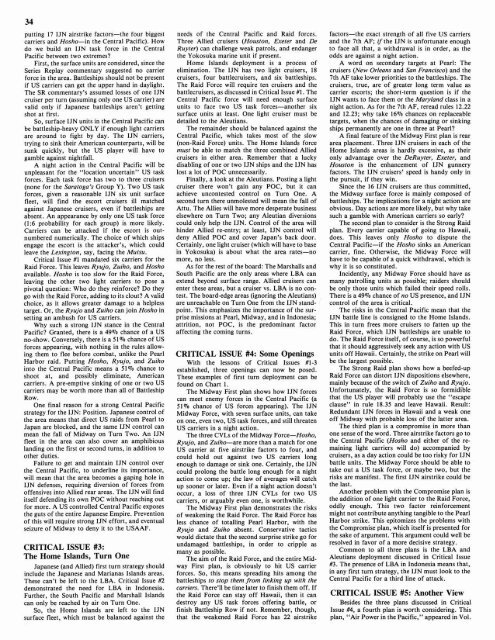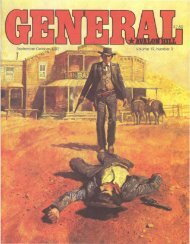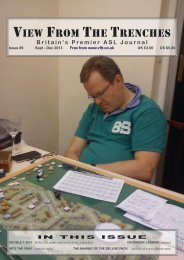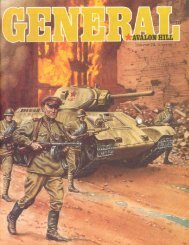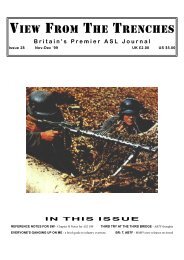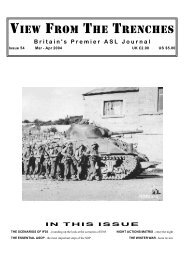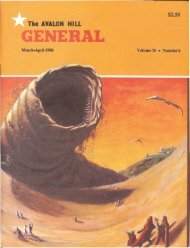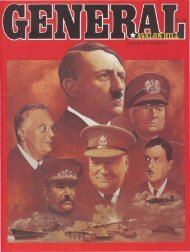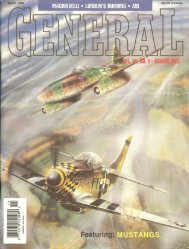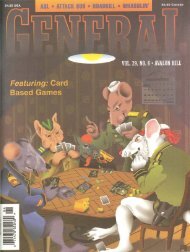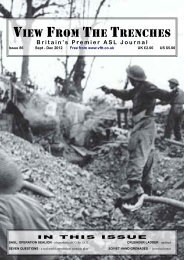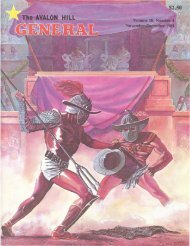18.64MB - View From The Trenches
18.64MB - View From The Trenches
18.64MB - View From The Trenches
- TAGS
- trenches
- www.vftt.co.uk
You also want an ePaper? Increase the reach of your titles
YUMPU automatically turns print PDFs into web optimized ePapers that Google loves.
putting 17 IJN airstrike factors-the four biggest<br />
carriers and Hosho-in the Central Pacific). How<br />
do we build an IJN task force in the Central<br />
Pacific between two extremes?<br />
First, the surface units are considered, since the<br />
Series Replay commentary suggested no carrier<br />
force in the area. Battleships should not be present<br />
if US carriers can get the upper hand in daylight.<br />
<strong>The</strong> SR commentary's assumed losses of one IJN<br />
cruiser per turn (assuming only one US carrier) are<br />
valid only if Japanese battleships aren't getting<br />
shot at first.<br />
So, surface IJN units in the Central Pacific can<br />
be battleship-heavy ONLY if enough light carriers<br />
are around to fight by day. <strong>The</strong> IJN carriers,<br />
trying to sink their American counterparts, will be<br />
sunk quickly, but the US player will have to<br />
gamble against nightfall.<br />
A night action in the Central Pacific will be<br />
unpleasant for the "location uncertain" US task<br />
forces. Each task force has two to three cruisers<br />
(none for the Saratoga's Group Y). Two US task<br />
forces, given a reasonable IJN six unit surface<br />
fleet, will find the escort cruisers ill matched<br />
against Japanese cruisers, even if battleships are<br />
absent. An appearance by only one US task force<br />
(1:6 probability for each group) is more likely.<br />
Carriers can be attacked if the escort is out-<br />
numbered numerically. <strong>The</strong> choice of which ships<br />
engage the escort is the attacker's, which could<br />
leave the Lexington, say, facing the Mutsu.<br />
Critical Issue #1 mandated six carriers for the<br />
Raid Force. This leaves Ryujo, Zuiho, and Hosho<br />
available. Hosho is too slow for the Raid Force,<br />
leaving the other two light carriers to pose a<br />
pivotal question: Who do they reinforce? Do they<br />
go with the Raid Force, adding to its clout? A valid<br />
choice, as it allows greater damage to a helpless<br />
target. Or, the Ryujo and Zuiho can join Hosho in<br />
setting an ambush for US carriers.<br />
Why such a strong IJN stance in the Central<br />
Pacific? Granted, there is a 49% chance of a US<br />
no-show. Conversely, there is a 51 % chance of US<br />
forces appearing, with nothing in the rules allow-<br />
ing them to flee before combat, unlike the Pearl<br />
Harbor raid. Putting Hosho, Ryujo, and Zuiho<br />
into the Central Pacific means a 51% chance to<br />
shoot at, and possibly eliminate, American<br />
carriers. A pre-emptive sinking of one or two US<br />
carriers may be worth more than all of Battleship<br />
Row.<br />
One final reason for a strong Central Pacific<br />
strategy for the IJN: Position. Japanese control of<br />
the area means that direct US raids from Pearl to<br />
Japan are blocked, and the same IJN control can<br />
mean the fall of Midway on Turn Two. An IJN<br />
fleet in the area can also cover an amphibious<br />
landing on the first or second turns, in addition to<br />
other duties.<br />
Failure to get and maintain IJN control over<br />
the Central Pacific, to underline its importance,<br />
will mean that the area becomes a gaping hole in<br />
IJN defenses, requiring diversion of forces from<br />
offensives into Allied rear areas. <strong>The</strong> IJN will find<br />
itself defending its own POC without reaching out<br />
for more. A US controlled Central Pacific exposes<br />
the guts of the entire Japanese Empire. Prevention<br />
of this will require strong IJN effort, and eventual<br />
seizure of Midway to deny it to the USAAF.<br />
CRITICAL ISSUE #3:<br />
<strong>The</strong> Home Islands, Turn One<br />
Japanese (and Allied) first turn strategy should<br />
include the Japanese and Marianas Islands areas.<br />
<strong>The</strong>se can't be left to the LBA. Critical Issue #2<br />
demonstrated the need for LBA in Indonesia.<br />
Further, the South Pacific and Marshall Islands<br />
can only be reached by air on Turn One.<br />
So, the Home Islands are left to the IJN<br />
surface fleet, which must be balanced against the<br />
needs of the Central Pacific and Raid forces.<br />
Three Allied cruisers (Houston, Exeter and De<br />
Ruyter) can challenge weak patrols, and endanger<br />
the Yokosuka marine unit if present.<br />
Home Islands deployment is a process of<br />
elimination. <strong>The</strong> IJN has two light cruisers, 18<br />
cruisers, four battlecruisers, and six battleships.<br />
<strong>The</strong> Raid Force will require ten cruisers and the<br />
battlecruisers, as discussed in Critical Issue #1. <strong>The</strong><br />
Central Pacific force will need enough surface<br />
units to face two US task forces-another six<br />
surface units at least. One light cruiser must be<br />
detailed to the Aleutians.<br />
<strong>The</strong> remainder should be balanced against the<br />
Central Pacific, which takes most of the slow<br />
(non-Raid Force) units. <strong>The</strong> Home Islands force<br />
must be able to match the three combined Allied<br />
cruisers in either area. Remember that a lucky<br />
disabling of one or two IJN ships and the IJN has<br />
lost a lot of POC unnecessarily.<br />
Finally, a look at the Aleutians. Posting a light<br />
cruiser there won't gain any POC, but it can<br />
achieve uncontested control on Turn One. A<br />
second turn there unmolested will mean the fall of<br />
Attu. <strong>The</strong> Allies will have more desperate business<br />
elsewhere on Turn Two; any Aleutian diversions<br />
could only help the IJN. Control of the area will<br />
hinder Allied re-entry; at least, IJN control will<br />
deny Allied POC and cover Japan's back door.<br />
Certainly, one light cruiser (which will have to base<br />
in Yokosuka) is about what the area rates-no<br />
more, no less.<br />
As for the rest of the board: <strong>The</strong> Marshalls and<br />
South Pacific are the only areas where LBA can<br />
extend beyond surface range. Allied cruisers can<br />
enter these areas, but a cruiser vs. LBA is no con-<br />
test. <strong>The</strong> board-edge areas (ignoring the Aleutians)<br />
are unreachable on Turn One from the IJN stand-<br />
point. This emphasizes the importance of the sur-<br />
prise missions at Pearl, Midway, and in Indonesia;<br />
attrition, not POC, is the predominant factor<br />
affecting the coming turns.<br />
CRITICAL ISSUE #4: Some Openings<br />
With the lessons of Critical Issues #1-3<br />
established, three openings can now be posed.<br />
<strong>The</strong>se examples of first turn deployment can be<br />
found on Chart 1.<br />
<strong>The</strong> Midway First plan shows how IJN forces<br />
can meet enemy forces in the Central Pacific (a<br />
51% chance of US forces appearing). <strong>The</strong> IJN<br />
Midway Force, with seven surface units, can take<br />
on one, even two, US task forces, and still threaten<br />
US carriers in a night action.<br />
<strong>The</strong> three CVLs of the Midway Force-Hosho,<br />
Ryujo, and Zuiho-are more than a match for one<br />
US carrier at five airstrike factors to four, and<br />
could hold out against two US carriers long<br />
enough to damage or sink one. Certainly, the IJN<br />
could prolong the battle long enough for a night<br />
action to come up; the law of averages will catch<br />
up sooner or later. Even if a night action doesn't<br />
occur, a loss of three IJN CVLs for two US<br />
carriers, or arguably even one, is worthwhile.<br />
<strong>The</strong> Midway First plan demonstrates the risks<br />
of weakening the Raid Force. <strong>The</strong> Raid Force has<br />
less chance of totalling Pearl Harbor, with the<br />
Ryujo and Zuiho absent. Conservative tactics<br />
would dictate that the second surprise strike go for<br />
undamaged battleships, in order to cripple as<br />
many as possible.<br />
<strong>The</strong> aim of the Raid Force, and the entire Mid-<br />
way First plan, is obviously to hit US carrier<br />
forces. So, this means spreading hits among the<br />
battleships to stop them from linking up with the<br />
carriers. <strong>The</strong>re'll be time later to finish them off. If<br />
the Raid Force can stay off Hawaii, then it can<br />
destroy any US task forces offering battle, or<br />
finish Battleship Row if not. Remember, though,<br />
that the weakened Raid Force has 22 airstrike<br />
factors-the exact strength of all five US carriers<br />
and the 7th AF; if the IJN is unfortunate enough<br />
to face all that, a withdrawal is in order, as the<br />
odds are against a night action.<br />
A word on secondary targets at Pearl: <strong>The</strong><br />
cruisers (New Orleans and Sun Francisco) and the<br />
7th AF take lower priorities to the battleships. <strong>The</strong><br />
cruisers, true, are of greater long term value as<br />
carrier escorts; the short-term question is if the<br />
IJN wants to face them or the Maryland class in a<br />
night action. As for the 7th AF, reread rules 12.22<br />
and 12.23; why take 16% chances on replaceable<br />
targets, when the chances of damaging or sinking<br />
ships permanently are one in three at Pearl?<br />
A final feature of the Midway First plan is rear<br />
area placement. Three IJN cruisers in each of the<br />
Home Islands areas is hardly excessive, as their<br />
only advantage over the DeRuyter, Exeter, and<br />
Houston is the enhancement of IJN gunnery<br />
factors. <strong>The</strong> IJN cruisers' speed is handy only in<br />
the pursuit, if they win.<br />
Since the 16 IJN cruisers are thus committed,<br />
the Midway surface force is mainly composed of<br />
battleships. <strong>The</strong> implications for a night action are<br />
obvious. Day actions are more likely, but why take<br />
such a gamble with American carriers so early?<br />
<strong>The</strong> second plan to consider is the Strong Raid<br />
plan. Every carrier capable of going to Hawaii,<br />
does. This leaves only Hosho to dispute the<br />
Central Pacific-if the Hosho sinks an American<br />
carrier, fine. Otherwise, the Midway Force will<br />
have to be capable of a quick withdrawal, which is<br />
why it is so constituted.<br />
Incidently, any Midway Force should have as<br />
many patrolling units as possible; raiders should<br />
be only those units which failed their speed rolls.<br />
<strong>The</strong>re is a 49% chance of no US presence, and IJN<br />
control of the area is critical.<br />
<strong>The</strong> risks in the Central Pacific mean that the<br />
IJN battle line is consigned to the Home Islands.<br />
This in turn frees more cruisers to fatten up the<br />
Raid Force, which IJN battleships are unable to<br />
do. <strong>The</strong> Raid Force itself, of course, is so powerful<br />
that it should aggressively seek any action with US<br />
units off Hawaii. Certainly, the strike on Pearl will<br />
be the largest possible.<br />
<strong>The</strong> Strong Raid plan shows how a beefed-up<br />
Raid Force can distort IJN dispositions elsewhere,<br />
mainly because of the switch of Zuiho and Ryujo.<br />
Unfortunately, the Raid Force is so formidible<br />
that the US player will probably use the "escape<br />
clause" in rule 18.35 and leave Hawaii. Result:<br />
Redundant IJN forces in Hawaii and a weak one<br />
off Midway with probable loss of the latter area.<br />
<strong>The</strong> third plan is a compromise in more than<br />
one sense of the word. Three airstrike factors go to<br />
the Central Pacific (Hosho and either of the re-<br />
maining light carriers will do) accompanied by<br />
cruisers, as a day action could be too risky for IJN<br />
battle units. <strong>The</strong> Midway Force should be able to<br />
take out a US task force, or maybe two, but the<br />
risks are manifest. <strong>The</strong> first IJN airstrike could be<br />
the last.<br />
Another problem with the Compromise plan is<br />
the addition of one light carrier to the Raid Force,<br />
oddly enough. This two factor reinforcement<br />
might not contribute anything tangible to the Pearl<br />
Harbor strike. This epitomizes the problems with<br />
the Compromise plan, which itself is presented for<br />
the sake of argument. This argument could well be<br />
resolved in favor of a more decisive strategy.<br />
Common to all three plans is the LBA and<br />
Aleutians deployment discussed in Critical Issue<br />
#3. <strong>The</strong> presence of LBA in Indonesia means that,<br />
in any first turn strategy, the IJN must look to the<br />
Central Pacific for a third line of attack.<br />
CRITICAL ISSUE #5: Another <strong>View</strong><br />
Besides the three plans discussed in Critical<br />
Issue #4, a fourth plan is worth considering. This<br />
plan, "Air Power in the Pacific," appeared in Vol.


